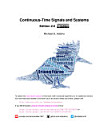Handbook of Signal Processing Systems
Shuvra S. Bhattacharyya · Ed F. Deprettere · Rainer Leupers · Jarmo Takala
ਸਤੰ 2010 · Springer Science & Business Media
5.0star
2 ਸਮੀਖਿਆਵਾਂreport
ਈ-ਕਿਤਾਬ
1117
ਪੰਨੇ
reportਰੇਟਿੰਗਾਂ ਅਤੇ ਸਮੀਖਿਆਵਾਂ ਦੀ ਪੁਸ਼ਟੀ ਨਹੀਂ ਕੀਤੀ ਗਈ ਹੈ ਹੋਰ ਜਾਣੋ
ਇਸ ਈ-ਕਿਤਾਬ ਬਾਰੇ
It gives me immense pleasure to introduce this timely handbook to the research/- velopment communities in the ?eld of signal processing systems (SPS). This is the ?rst of its kind and represents state-of-the-arts coverage of research in this ?eld. The driving force behind information technologies (IT) hinges critically upon the major advances in both component integration and system integration. The major breakthrough for the former is undoubtedly the invention of IC in the 50’s by Jack S. Kilby, the Nobel Prize Laureate in Physics 2000. In an integrated circuit, all components were made of the same semiconductor material. Beginning with the pocket calculator in 1964, there have been many increasingly complex applications followed. In fact, processing gates and memory storage on a chip have since then grown at an exponential rate, following Moore’s Law. (Moore himself admitted that Moore’s Law had turned out to be more accurate, longer lasting and deeper in impact than he ever imagined. ) With greater device integration, various signal processing systems have been realized for many killer IT applications. Further breakthroughs in computer sciences and Internet technologies have also catalyzed large-scale system integration. All these have led to today’s IT revolution which has profound impacts on our lifestyle and overall prospect of humanity. (It is hard to imagine life today without mobiles or Internets!) The success of SPS requires a well-concerted integrated approach from mul- ple disciplines, such as device, design, and application.
ਰੇਟਿੰਗਾਂ ਅਤੇ ਸਮੀਖਿਆਵਾਂ
5.0
2 ਸਮੀਖਿਆਵਾਂ
ਲੇਖਕ ਬਾਰੇ
Shuvra S. Bhattacharyya is a Professor in the Department of Electrical and Computer Engineering University of Maryland at College Park. He holds a joint appointment in the University of Maryland Institute for Advanced Computer Studies (UMIACS. Dr. Bhattacharyya is coauthor or coeditor of five books and the author or coauthor of more than 150 refereed technical articles. Dr. Bhattacharyya is director of the Maryland DSPCAD Research Group. He serves as associate editor for the EURASIP Journal on Embedded Systems, International Journal of Embedded Systems, and Journal of Signal Processing Systems. Dr. Bhattacharyya has served as Chair of the IEEE Signal Processing Society Technical Committee on Design and Implementation of Signal Processing Systems (2008-2009). Dr. Bhattacharyya has been a Nokia Distinguished Lecturer (Finland, 2006) and Fulbright Senior Specialist (Germany, 2005 and Austria, 2009). He has received the NSF Career Award (1998). He has received Best Paper Awards at the International Workshop on Systems, Architectures, Modeling, and Simulation (2008); and IEEE Workshop on Signal Processing Systems (2007).
ਇਸ ਈ-ਕਿਤਾਬ ਨੂੰ ਰੇਟ ਕਰੋ
ਆਪਣੇ ਵਿਚਾਰ ਦੱਸੋ
ਪੜ੍ਹਨ ਸੰਬੰਧੀ ਜਾਣਕਾਰੀ
ਸਮਾਰਟਫ਼ੋਨ ਅਤੇ ਟੈਬਲੈੱਟ
Google Play Books ਐਪ ਨੂੰ Android ਅਤੇ iPad/iPhone ਲਈ ਸਥਾਪਤ ਕਰੋ। ਇਹ ਤੁਹਾਡੇ ਖਾਤੇ ਨਾਲ ਸਵੈਚਲਿਤ ਤੌਰ 'ਤੇ ਸਿੰਕ ਕਰਦੀ ਹੈ ਅਤੇ ਤੁਹਾਨੂੰ ਕਿਤੋਂ ਵੀ ਆਨਲਾਈਨ ਜਾਂ ਆਫ਼ਲਾਈਨ ਪੜ੍ਹਨ ਦਿੰਦੀ ਹੈ।
ਲੈਪਟਾਪ ਅਤੇ ਕੰਪਿਊਟਰ
ਤੁਸੀਂ ਆਪਣੇ ਕੰਪਿਊਟਰ ਦਾ ਵੈੱਬ ਬ੍ਰਾਊਜ਼ਰ ਵਰਤਦੇ ਹੋਏ Google Play 'ਤੇ ਖਰੀਦੀਆਂ ਗਈਆਂ ਆਡੀਓ-ਕਿਤਾਬਾਂ ਸੁਣ ਸਕਦੇ ਹੋ।
eReaders ਅਤੇ ਹੋਰ ਡੀਵਾਈਸਾਂ
e-ink ਡੀਵਾਈਸਾਂ 'ਤੇ ਪੜ੍ਹਨ ਲਈ ਜਿਵੇਂ Kobo eReaders, ਤੁਹਾਨੂੰ ਫ਼ਾਈਲ ਡਾਊਨਲੋਡ ਕਰਨ ਅਤੇ ਇਸਨੂੰ ਆਪਣੇ ਡੀਵਾਈਸ 'ਤੇ ਟ੍ਰਾਂਸਫਰ ਕਰਨ ਦੀ ਲੋੜ ਹੋਵੇਗੀ। ਸਮਰਥਿਤ eReaders 'ਤੇ ਫ਼ਾਈਲਾਂ ਟ੍ਰਾਂਸਫਰ ਕਰਨ ਲਈ ਵੇਰਵੇ ਸਹਿਤ ਮਦਦ ਕੇਂਦਰ ਹਿਦਾਇਤਾਂ ਦੀ ਪਾਲਣਾ ਕਰੋ।







